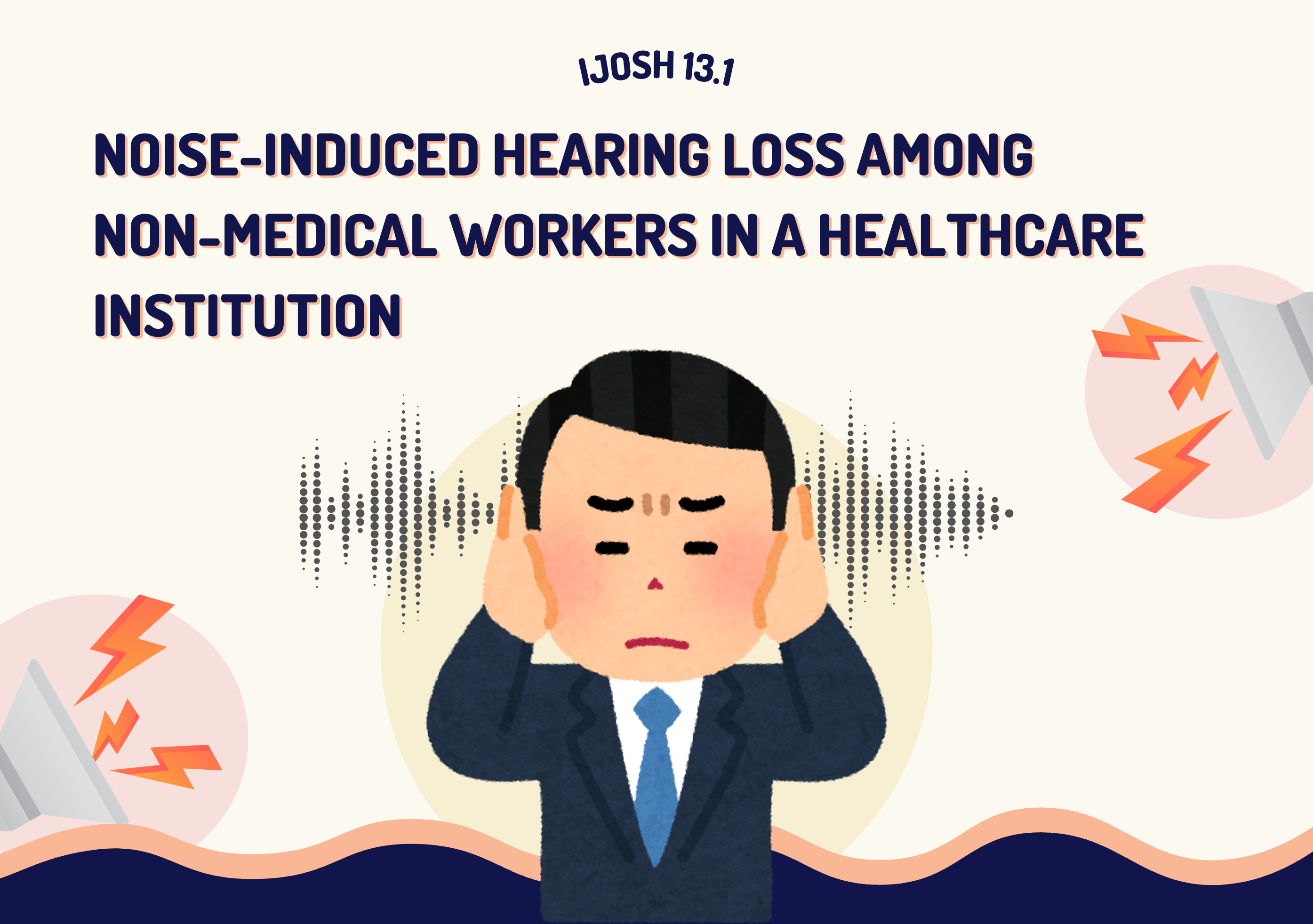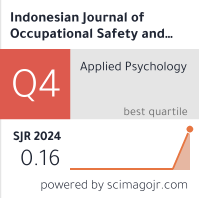Noise-induced Hearing Loss among Non-Medical Workers in a Healthcare Institution

Downloads
Introduction: The effects of prolonged and excessive noise exposure on healthcare workers have not been studied. This
study aims to estimate the prevalence of hearing loss among such workers and correlate the degree of hearing loss with age,
duration of exposure, and coexisting illnesses. Methods: A retrospective review of 117 clinical records was conducted on
179 employees working in areas of excessive noise in a tertiary care hospital. Correlations between categorical variables
were made using the Chi-square and Fisher's exact tests, while an independent samples t-test was used to compare means
for continuous variables. Binary logistic regression was used to quantify the strength of correlations through an odds
ratio and 95% confidence interval. Results: A clinical evaluation was conducted to assess hearing loss on employees
from various departments, including Boiler Section, Central Sterile Supply Department (CSSD), Laundry, Prosthetics
and Orthotics Laboratory, and Dietary. The median age of the participants was 37 years. Out of the 116 participants who
underwent by audiological tests, 63.8% had sensorineural hearing loss and 68.5% had absent otoacoustic emissions in at
least one frequency. The incidence of hearing loss was found to increase with age (p = 0.037). A significant correlation
was noted between hearing loss and the duration of noise exposure of more than 10 years (p = 0.0013). Considering all
areas together, a significantly higher proportion of employees with hearing loss was observer (p = 0.044), with 69.5% in
the CSSD. Conclusion: Noise-induced hearing loss is a prevalent occupational health hazard in healthcare settings. The
risk of developing hearing loss increases with the duration of work in a noise-generating area.
Astin, F. et al. (2020) ‘Night-time Noise Levels and Patients' Sleep Experiences in a Medical Assessment Unit in Northern England', The Open Nursing Journal, 14(1), pp. 80–91. Available at: https://doi.org/10.2174/1874434602014010080.
Blioskas, S. et al. (2018) ‘Utility of Otoacoustic Emissions and Olivocochlear Reflex in Predicting Vulnerability to Noise-Induced Inner Ear Damage', Noise & Health, 20(94), pp. 101–111. Available at: https://doi.org/10.4103/nah.NAH_61_17.
Brown, C.S. et al. (2018) ‘Global Hearing Loss Prevention', Otolaryngologic Clinics of North America, 51(3), pp. 575–592. Available at: https://doi.org/10.1016/j.otc.2018.01.006.
Chang, T.-Y. et al. (2011) ‘High-Frequency Hearing Loss, Occupational Noise Exposure and Hypertension: A Cross-Sectional Study in Male Workers', Environmental Health, 10, p. 35. Available at: https://doi.org/10.1186/1476-069X-10-35.
Chang, T.-Y. et al. (2020) ‘Occupational Noise Exposure and its Association with Incident Hyperglycaemia: A Retrospective Cohort Study', Scientific Reports, 10. Available at: https://doi.org/10.1038/s41598-020-65646-1.
Clark, J.G. (1981) ‘Uses and Abuses of Hearing Loss Classification', ASHA, 23(7), pp. 493–500.
Feder, K. et al. (2017) ‘Prevalence of Hazardous Occupational Noise Exposure, Hearing Loss, and Hearing Protection Usage Among a Representative Sample of Working Canadians', Journal of Occupational and Environmental Medicine, 59(1), pp. 92–113. Available at: https://doi.org/10.1097/JOM.0000000000000920.
Furness, D.N. (2015) ‘Molecular Basis of Hair Cell Loss', Cell and Tissue Research, 361(1), pp. 387–399. Available at: https://doi.org/10.1007/s00441-015-2113-z.
Government of Canada, C.C. for O.H. and S. (2017) Noise - Control Measures : OSH Answers. Available at: https://www.ccohs.ca/oshanswers/phys_agents/noise_control.html (Accessed: 13 July 2022).
Gratias, P. et al. (2021) ‘Impulse Noise Induced Hidden Hearing Loss, Hair Cell Ciliary Changes and Oxidative Stress in Mice', Antioxidants, 10(12), p. 1880. Available at: https://doi.org/10.3390/antiox10121880.
Haile, L.M. et al. (2021) ‘Hearing Loss Prevalence and Years Lived with Disability, 1990–2019: Findings from the Global Burden of Disease Study 2019', The Lancet, 397(10278), pp. 996–1009. Available at: https://doi.org/10.1016/S0140-6736(21)00516-X.
Hamoud1, A.A.H.A. and AL-Hakkak1, Z.M.M.H. (2020) ‘Evaluation of Noise Pollution Levels in Hospitals and its Effects on Staff Health in AL - Najaf City in Iraq', Indian Journal of Forensic Medicine & Toxicology, 14(1), pp. 899–905. Available at: https://doi.org/10.37506/ijfmt.v14i1.167.
Han, W.K. et al. (2018) ‘Susceptibility of Diabetic Mice to Noise Trauma', BioMed Research International, 2018, pp. 1–9. Available at: https://doi.org/10.1155/2018/7601232.
Helleman, H.W., Jansen, E.J.M. and Dreschler, W.A. (2010) ‘Otoacoustic Emissions in a Hearing Conservation Program: General Applicability in Longitudinal Monitoring and the Relation to Changes in Pure-tone Thresholds', International Journal of Audiology, 49(6), pp. 410–419. Available at: https://doi.org/10.3109/14992020903527616.
Hisam, A. and Anua, S.M. (2018) ‘Noise Exposure and Hearing Symptoms Among Laundry Workers and Mechanical Cutters in a Teaching Hospital', Journal of Occupational Safety and Health, 15(1), p. 35.
Kerns, E. et al. (2018) ‘Cardiovascular Conditions, Hearing Difficulty, and Occupational Noise Exposure within US Industries and Occupations', American Journal of Industrial Medicine, 61(6), pp. 477–491. Available at: https://doi.org/10.1002/ajim.22833.
Khaiwal, R. et al. (2016) ‘Assessment of Noise Pollution in and Around a Sensitive Zone in North India and its Non-Auditory Impacts', Science of The Total Environment, 566–567, pp. 981–987. Available at: https://doi.org/10.1016/j.scitotenv.2016.05.070.
Kim, D.Y. et al. (2019) ‘The Effect of Diabetes on 4-year Changes of Hearing Thresholds in Male Workers Exposed to Noise in a Single Company: A Longitudinal Study', Annals of Occupational and Environmental Medicine, 31, p. e11. Available at: https://doi.org/10.35371/aoem.2019.31.e11.
Lie, A. et al. (2016) ‘Occupational Noise Exposure and Hearing: A Systematic Review', International Archives of Occupational and Environmental Health, 89, pp. 351–372. Available at: https://doi.org/10.1007/s00420-015-1083-5.
Liu, J. et al. (2016) ‘Prevalence of Hypertension and NIHL in Chinese Coal Miners', Journal of Thoracic Disease, 8(3), pp. 422–429. Available at: https://doi.org/10.21037/jtd.2016.02.59.
Loupa, G. et al. (2019) ‘Mapping the Noise in a Greek General Hospital', The Science of the Total Environment, 646, pp. 923–929. Available at: https://doi.org/10.1016/j.scitotenv.2018.07.315.
Masterson, E.A. (2016) ‘Hearing Impairment Among Noise-Exposed Workers ” United States, 2003–2012', MMWR. Morbidity and Mortality Weekly Report, 65. Available at: https://doi.org/10.15585/mmwr.mm6515a2.
McBride, D. and Williams, S. (2001) ‘Characteristics of the Audiometric Notch as a Clinical Sign of Noise Exposure', Scandinavian Audiology, 30(2), pp. 106–111. Available at: https://doi.org/10.1080/010503901300112211.
Nelson, D.I. et al. (2005) ‘The global burden of occupational NIHL', American Journal of Industrial Medicine, 48(6), pp. 446–458. Available at: https://doi.org/10.1002/ajim.20223.
Pleban, D. et al. (2021) ‘Assessment of Working Conditions in Medical Facilities due to Noise', International Journal of Occupational Safety and Ergonomics, 27(4), pp. 1199–1206. Available at: https://doi.org/10.1080/10803548.2021.1987692.
Reducing Noise Exposure: Noise Controls | NIOSH | CDC (2021). Available at: https://www.cdc.gov/niosh/topics/noise/reducenoiseexposure/noisecontrols.html (Accessed: 13 July 2022).
Ryan, A.F. et al. (2016) ‘Temporary and Permanent Noise-Induced Threshold Shifts: A Review of Basic and Clinical Observations', Otology & Neurotology, 37(8), pp. e271–e275. Available at: https://doi.org/10.1097/MAO.0000000000001071.
Walton, A.L. and Rogers, B. (2017) ‘Workplace Hazards Faced by Nursing Assistants in the United States: A Focused Literature Review', International Journal of Environmental Research and Public Health, 14(5), p. 544. Available at: https://doi.org/10.3390/ijerph14050544.
Yang, Y. et al. (2018) ‘Relationship between Occupational Noise Exposure and the Risk Factors of Cardiovascular Disease in China', Medicine, 97(30), p. e11720. Available at: https://doi.org/10.1097/MD.0000000000011720.
Copyright (c) 2024 The Indonesian Journal Of Occupational Safety and Health

This work is licensed under a Creative Commons Attribution-NonCommercial-ShareAlike 4.0 International License.

In order to be accepted and published by The Indonesian Journal of Occupational Safety and Health, Author(s) who submit an article should complete all the review process. The copyright of received articles assigned to the The Indonesian Journal of Occupational Safety and Health and Department of Safety and Health, Universitas Airlangga as publishers of the journal. The intended copyright includes the rights to publish articles in various forms (including reprints).
The Editorial Team of The Indonesian Journal Of Occupational Safety and Health and Department of Safety and Health strive to ensure that no errors occur in the articles that have been published, both data errors and statements in the article.
Users of this website will be licensed to use materials from this website following the Creative Commons Attribution-NonCommercial-ShareAlike 4.0 International License. No fees charged. Please use the materials accordingly.
------------------------------------------------------------------------------------------------------------------------------------------------------------------------------------------
Attribution ” You must give appropriate credit, provide a link to the license, and indicate if changes were made. You may do so in any reasonable manner, but not in any way that suggests the licensor endorses you or your use.
NonCommercial ” You may not use the material for commercial purposes.
ShareAlike ” If you remix, transform, or build upon the material, you must distribute your contributions under the same license as the original.







 How to Submit Articles in OJS
How to Submit Articles in OJS

























